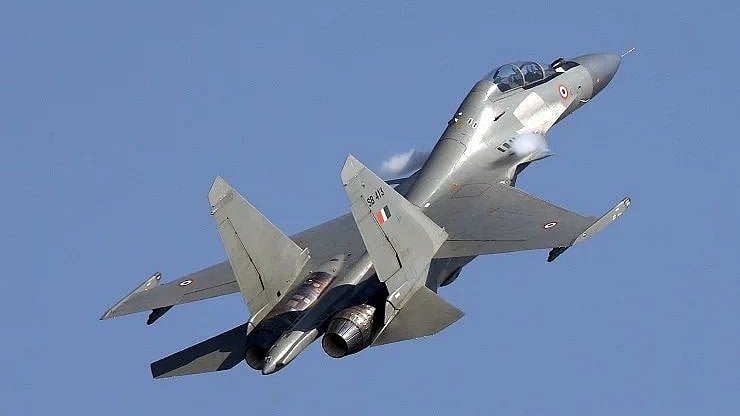Nation
IAF’s Sukhoi 30MKI to train with French jets in ‘Garuda 25’ military drills
Exercise is crucial opportunity to enhance interoperability, especially at a time when the two nations are expanding cooperation in defence procurement, high-technology

The Indian Air Force’s frontline Sukhoi 30MKI (Su-30MKI) jets will participate in an intensive round of air combat drills with French multi-role fighters as part of the bilateral Exercise Garuda 25, scheduled from 16 to 27 November at Mont-de-Marsan Air Base in France.
This marks the eighth edition of the Indo-French air exercise, one of the longest-running bilateral engagements between the two air forces and an important pillar of strategic defence cooperation between New Delhi and Paris.
The IAF contingent landed in France on 10 November, equipped with Su-30MKI fighter aircraft, supported by a full complement of transport and refuelling assets. The Ministry of Defence said that the C-17 Globemaster III has been deployed for airlift during induction and de-induction phases, while IL-78 mid-air refuelling tankers will extend the range and endurance of fighters during the drills.
According to officials, the exercise will involve complex, high-intensity simulated combat scenarios, including:
Air-to-air combat between mixed fighter packages
Air defence missions under contested environments
Joint strike operations simulating deep offensive missions
The ministry said these engagements are designed to mirror “a realistic operational environment”, allowing pilots and mission planners to refine tactics, validate procedures and test their mettle in unfamiliar terrain alongside allied forces.
Beyond flying operations, Garuda 25 will also include professional interactions, technical exchanges, and joint briefings aimed at deepening understanding between the two services. Both sides are expected to share best practices on combat readiness, mission planning, crew coordination, electronic warfare, and safety procedures.
Officials described the exercise as a crucial opportunity to enhance interoperability, especially at a time when the two nations are expanding cooperation in defence procurement, high-technology.
Participation in Garuda 25, the ministry emphasised, underscores the IAF’s commitment to “constructive engagement with friendly foreign air forces”, through both bilateral and multilateral exercises. Such collaborations, it said, are vital for strengthening air power capabilities, improving operational synergy, and promoting mutual trust.
With the Su-30MKIs flying alongside French fighters over European skies for nearly two weeks, officials said the exercise will “significantly contribute” to the IAF’s experience in diverse threat environments and enhance joint preparedness for future contingencies.
Published: undefined
Spearhead of IAF's fighter fleet
In the IAF arsenal, the Sukhoi Su-30MKI is often referred to as the spearhead of its fighter fleet, highlighting its role as the principal air superiority and multirole combat aircraft providing critical strike and air dominance capabilities.
The Sukhoi Su-30MKI is known for its long range, heavy payload, and exceptional manoeuvrability. Designed jointly by Russia’s Sukhoi Design Bureau and HAL (India’s Hindustan Aeronautics Limited), it represents one of India’s most successful defence collaborations.
It is important to mention that while Rafale is IAF's most advanced fighter jet but aspects of Sukhoi 30MKI that make it superior to Rafale are:
Longer range and endurance for extended missions.
Superior supermaneuverability and close-combat agility.
Larger weapons payload capacity.
Powerful thrust vectoring engines for enhanced dogfight performance.
A key highlight of the Su-30MKI is its thrust-vectoring capability, which allows the aircraft to perform extreme manoeuvres like the famous Cobra and Tail Slide, giving it a significant edge in close-combat situations. The jet also carries a powerful radar, can undertake long-duration missions, and supports multiple weapon systems of both Russian and Western origin.
Key specialties of the Su-30MKI:
Super-manoeuvrability due to thrust-vectoring engines
Long-range strike capability with heavy payloads
Advanced avionics including phased-array radar
Russia played a crucial role in enabling India to produce the aircraft domestically. Under a long-term technology transfer agreement, Russia supplied design blueprints, manufacturing know-how, and engine technology for India to licence-build the fighter at HAL’s Nashik facility. Over time, HAL indigenised a large portion of the components, making the Su-30MKI one of the most “Made in India” frontline jets.
How Russia helped India build them:
Full transfer of technology (ToT) for airframe, avionics integration and assembly
Supply of AL-31FP engines and guidance on local manufacturing
Joint development inputs to customise the aircraft for Indian needs. The Russian acronym MKI (Modernizirovannyi Kommercheskiy Indiski) literally translates in English as Modernised Commercial Indian.
Today, more than 260 Su-30MKIs serve as the backbone of the IAF, and India are constantly developing upgrades such as new radars, weapons, and electronic warfare systems — with Russia still involved as a key partner.
Published: undefined
Follow us on: Facebook, Twitter, Google News, Instagram
Join our official telegram channel (@nationalherald) and stay updated with the latest headlines
Published: undefined